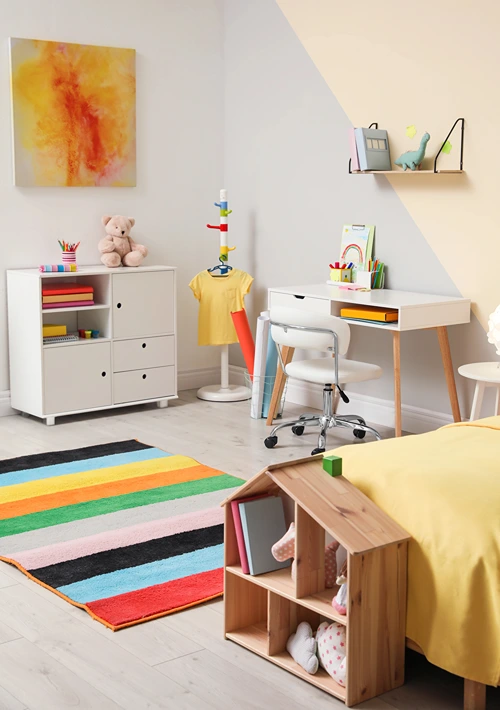Simple Ways to Make Your Child’s Room Feel Safe and Inviting
Creating a safe and inviting space for your child is essential to their emotional well-being and development. A child’s room is more than just a place to sleep—it is their personal retreat, a space where they play, learn, and unwind. A well-designed environment fosters a sense of security, encourages creativity, and ensures comfort.
Parents often focus on aesthetics when designing their child’s room, but safety and emotional warmth should be top priorities. From selecting the right bedding to incorporating calming elements, small changes can make a big difference. Below are practical ways to transform your child’s space into a comforting and secure haven.
Choosing Soft and Soothing Colours
The colour scheme of a room has a profound impact on mood. Bright, energetic colours might be fun for play areas, but soft and soothing hues are ideal for creating a calming bedroom environment. Pastel shades, warm neutrals, and nature-inspired tones help to instil a sense of peace and relaxation.
Soft blues and greens can promote tranquillity, while warm beige, blush, or soft greys can make the space feel snug and welcoming. Avoid overly bright or clashing colours, as they can be overstimulating and may interfere with sleep and relaxation.
Enhancing Sleep Quality with Eco-Friendly, Cosy Bedding
A comfortable bed is the foundation of a restful and inviting space. Soft, high-quality bedding can improve sleep quality while creating a sense of warmth and security. One of the best ways to elevate comfort is by choosing the right duvet and ensuring it is paired with well-made bamboo duvet covers.
These covers are not only soft and breathable but also naturally hypoallergenic, making them an excellent choice for children with sensitive skin or allergies. Bamboo fabric regulates temperature efficiently, keeping the bed cool in summer and warm in winter, ensuring year-round comfort.
Additionally, bamboo duvet covers are eco-friendly and highly durable, maintaining their softness and quality even after multiple washes. High-quality covers enhance the aesthetic of the room while providing an added layer of softness and durability, ensuring a comfortable night’s sleep.
To learn more about increasing the quality of sleep and various other products, visit your nearest Panda London showroom or speak to an expert.
Incorporating Gentle Lighting
Lighting plays a crucial role in setting the tone of a child’s room. Harsh overhead lights can feel sterile and unwelcoming, while soft, layered lighting creates warmth and comfort. A combination of warm-toned ceiling lights, bedside lamps, and fairy lights can add depth to the space and enhance its inviting nature.
Nightlights with adjustable brightness can provide reassurance to children who feel uneasy in the dark. Dimmable lamps also allow for a smoother transition from playtime to bedtime, signalling the body to wind down for the night.
Organising the Room for a Sense of Security
A clutter-free room promotes relaxation and reduces feelings of overwhelm. An organised space also creates a sense of order, which is particularly beneficial for young children. Simple storage solutions such as low-level shelves, toy chests, and labelled bins help keep everything in place while allowing easy access to toys and essentials.
Designating specific areas for sleep, play, and study can help structure the room in a way that feels balanced and functional. When children know where everything belongs, they feel more in control of their space, which can contribute to their overall sense of security and well-being.
Adding Personal Touches
Personalisation plays a huge role in making a child’s room feel like their own, especially if they are sharing a bedroom with a sibling. Including elements that reflect their personality and interests can create an emotional connection to their space. Family photos, favourite artwork, or personalised name signs can help make the room feel more familiar and comforting.
Letting children choose certain aspects of their décor—such as bedding patterns, wall art, or decorative cushions—gives them a sense of ownership over their space.
Incorporating Soft and Safe Textures
The textures within a room contribute significantly to its overall feel. Plush rugs, soft blankets, and cushioned seating areas create an inviting environment that encourages relaxation. When selecting furniture and décor, opt for child-friendly materials that are soft to the touch and free from sharp edges.
Layering different textures, such as woven baskets for storage, velvet cushions, or chunky knit throws, can add warmth and depth to the space. A well-textured environment provides sensory comfort and makes the room feel cosier and more secure.
Ensuring a Safe Sleeping Environment
Safety is the most important aspect of any child’s room. Choosing non-toxic materials, ensuring furniture is securely anchored, and removing potential hazards all contribute to a secure environment. If the room has windows, installing childproof locks and blackout blinds can enhance both safety and comfort.
Beds should be sturdy, with properly fitted mattresses and breathable bedding to promote safe and comfortable sleep. If bunk beds are used, guardrails should be in place to prevent falls.
Encouraging a Calming Bedtime Routine
A structured bedtime routine can reinforce the sense of security within a child’s room. Soft lighting, a cosy reading nook, and a comfortable bed all help signal that it is time to wind down for the night. Establishing a bedtime ritual—such as reading a story, listening to soothing music, or practising gentle breathing exercises—can make the transition to sleep smoother and more reassuring.
The room itself should support a restful environment, with minimal distractions and a consistent atmosphere conducive to relaxation. By maintaining a predictable routine, children feel more at ease in their space and develop healthy sleep habits.
Providing a Space for Play and Creativity
While comfort and safety are priorities, a child’s room should also be a space for imagination and self-expression. Including a dedicated play area with soft flooring, interactive elements, and a cosy corner for reading encourages creative exploration in a secure setting.
Fostering a Sense of Independence
A safe and inviting room should also encourage independence. Thoughtfully designed spaces that cater to a child’s needs help instil confidence and self-sufficiency. Low-level storage, easy-to-use light switches, and furniture suited to their height empower children to navigate their space independently.
Providing a space where they can comfortably get dressed, pick out books, or put away their toys without assistance fosters a sense of responsibility. When children feel comfortable managing their own environment, they develop a stronger sense of security and confidence.
All in all, creating a safe and inviting room for your child involves a careful balance of comfort, security, and personalisation. Thoughtful choices in bedding, lighting, colour schemes, and storage solutions all contribute to a nurturing environment.







